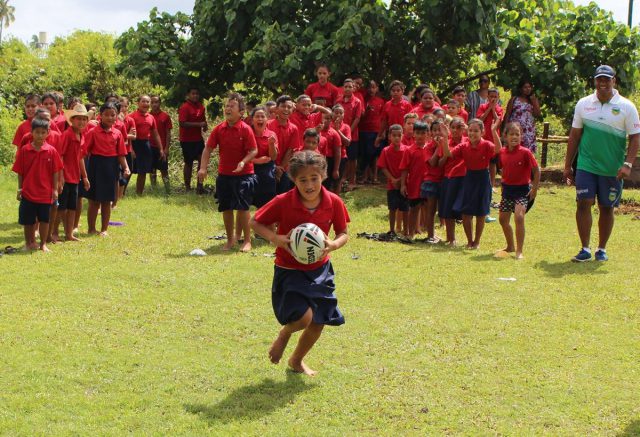
Often, Australian policy in the South Pacific is aid policy.
Our development assistance and aid dollars are always alive and active and about in the Islands, doing essential work even when Canberra’s attention is elsewhere.
Lots of other bits of the Australian government carry a Pacific load—especially the diplomats and the defenceniks. But in the day-to-day running of Island governments and the lives of Islanders, Australian aid is a constant.
Stress that this is a discussion about Oz government policy. Beyond Canberra, there are lots of other forms of Pacific ‘policy’ run by families and churches and banks and airlines and schools and hospitals. Those other elements form a large part of the ‘why’ of our Pacific thinking. Aid is a big part of the ‘how’.
For extended periods over the past five decades, certainly since Papua New Guinea’s independence in 1975, that truism—our Pacific policy is our aid policy—functioned as both criticism and praise.
The praise side was that the aid dollars are vital. The attack point was that Canberra wasn’t paying enough attention, leaving aid to provide the vision and demonstrate the commitment. Another part of the attack was that if ‘Pacific policy is aid policy’ and the Islands are perceived to be failing, then aid policy is failing.
The failing proposition brings us to a big South Pacific fact that lives in plain view. Not many things are permanent in the world of states, but as far out as anyone can see, South Pacific states will be forever dependent on aid.
The Island catch-22 is the ‘paradox of relatively high per capita levels of aid and low rates of economic growth’—the Pacific limits to growth.
In the Pacific, real average income per capita has increased by less than 10% since 1990, compared with about 150% in Asia’s emerging market economies.
Aid policy is economic policy for the South Pacific: relationships with Australia, New Zealand, Japan, China, the US and the EU pay for government and run services. The just-completed Islands’ summit with Japan is an example of how aid-as-economics works.
The catch-22 reality shaped the announcement that the South Pacific will get $1.3 billion of Australia’s $4.2 billion aid budget. Even the toughest commentary about how nasty the Coalition government is to the aid budget—real cuts and an extended freeze on indexation to inflation (a cut by attrition)—noted that the Islands did well.
To rearrange the order of my truism, Oz aid policy is now the South Pacific.
The Coalition has worked out that mauling aid doesn’t cost votes. To the charge that aid has plunged to its lowest-ever level of 0.22% of national income, the government simply responds with a line that works well in voter-land: $4 billion is a lot of money.
What’s interesting is that the government can be rough on aid, but needs to be nice to the Islands. There’s a voter-land element in this contradiction, a focus on ‘our neighbourhood’ that puts a positive face to aid. In the South Pacific, the dollars are going to people and places we know.
The Coalition base detests freebies for foreigners, yet the response is different if it’s about Papua New Guinea and the Islands and Timor-Leste. That’s why Canberra stumps up for PNG each budget, and why Australians firmly embraced long commitments to Timor, Bougainville, and the 14-year/$3 billion effort to save and rebuild Solomon Islands.
More than geopolitics are at work, although if a China ‘scare’ gets us to pay proper attention to the near neighbourhood we tend to set-and-forget, then thanks for the nudge.
In using the South Pacific descriptor, please stretch your geographic settings. When Australia thinks about the island arc, it looks to the north to start in Timor-Leste, then turns east to sweep through Papua New Guinea into the South Pacific. This is a Canberra conceptual convention that matters.
The aid budget groups Timor as part of Southeast Asia. In discussing Australia’s commitments to the Islands, though, it makes more sense to include Timor in our ‘arc of responsibility’. That’s why Timorese join Islanders in coming to do work in Australia under the Seasonal Worker Program. Adding in the $90 million of aid to Timor means the total annual spend on the Islands is close to $1.4 billion.
The aid announcements in this federal budget build on Canberra’s offer to the Islands of economic and security ‘integration’ with Australia (and New Zealand). The integration agenda in last November’s foreign policy white paper should become a long-lived landmark in our Pacific policy.
The forever commitment to give aid to the Islands is a vital expression of Australia’s role and responsibility and interests. However, to use a fine bit of logic terminology, Australian aid is necessary but not sufficient.
Integration is an offer to the South Pacific that goes beyond aid. Integration builds on what Australia gives to imagine what we can do together with the Islands. Integration proposes a different key to unlock the catch-22 paradox of the Pacific.

